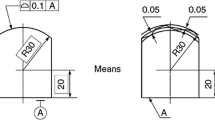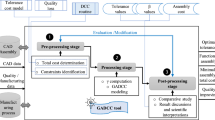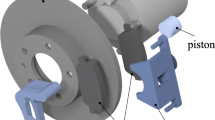Abstract
To guarantee the successful transformation from product functional requirement to geometry constraints and finally to dimension constraints between components in a product, an evolutionary tolerance design strategy is proposed on the basis of automation technology in product structure design. In the first part of this paper, the theory of the growth design and the process of tolerance evolutionary design are introduced. Following the evolution of product structure, product tolerance grows from its initial state, defined by accuracy requirements, to its final state, defined as dimension tolerance and geometric tolerance. In this growing process, the basic units in the product growth design, known as functional surfaces and their nominal features, are used as evolutionary carriers. With the help of these basic units, the method for the construction of a two-layer correlation network is proposed. In the second part, the tolerance assertions to assist tolerance evolutionary design are given, based on which the basic process for an evolutionary design of dimensions chain and geometric tolerance are presented. In order to optimize the allocation of the dimension tolerance, a mathematical model is developed in which a correlated sensitivity function between the cost and the tolerance is created. In the model, the design cost, the manufacturing cost, the usage cost, and the depreciation cost of the product are used as constraints to the tolerance allocation. Considering these costs, a multifactor cost function to express quality loss of the product is developed and is applied into the model. The minimum cost is used as the objective function, and the depreciation cost in the objective function is expressed by the discount rate—terminology in economics. The aim was to achieve a final and ideal balance around assembly, manufacturing, and usage through the control of product precision. In the last part, the successful usage of the proposed tolerance evolutionary strategy in the incremental growth product design is demonstrated through a design example.
Similar content being viewed by others
References
Holland JH (1975) Adaptation in natural and artificial systems. The University of Michigan Press, Ann Arbor
Gu XJ, Tan JR, Qi GN (1997) Genetic model for mechanical product information. Chin Mech Eng 8(2):77–79
Huang KZ (2006) Growth design modeling. Proceedings of ASME DETC2006/99151, Philadelphia
Pham DT, Yang Y (1993) A genetic algorithm based preliminary design system. J Automob Eng 207(D2):127–133. doi:10.1243/PIME_PROC_1993_207_170_02
Chen KZ, Feng XA (2002) Exploring a genetics-based design theory and methodology for innovating products. Proceedings of the 6th International Conference on Engineering Design and Automation, Maui, Hawaii, USA, pp 278–283
Chen KZ, Feng XA (2003) A framework of the genetic-engineering-based design theory and methodology for product innovation. Proceedings of 14th International Conference on Engineering Design, Stockholm, Sweden, pp 1093–1099
Gero JS (2000) Computational models of innovative and creative design process. Technol Forecast Soc Change 64:183–196. doi:10.1016/S0040-1625(99)00105-5
Gero JS, Kazakov VA (2001) A genetic engineering extension to genetic algorithms. Evol Syst 9(1):71–92
Gero JS (1999) Extensions to evolutionary systems in design from genetic engineering and developmental biology. Proceedings of the 1999 Congress on Evolutionary Computation—CEC99, IEEE, Piscataway, NJ, pp 474–479
Gero JS, Kazakov VA (1998) Evolving design genes in space layout problems. Artif Intell Eng 12(3):163–176. doi:10.1016/S0954-1810(97)00022-8
Rosenman MA (1997) An exploration into evolutionary models for non-routine design. Artif Intell Eng 11:287–293. doi:10.1016/S0954-1810(96)00046-5
Rosenman MA (1996) A growth model for form generation using a hierarchical evolutionary approach. Microcomputers in Civil Engineering Spec Issue Evol Syst Des 11:161–172
Rosenman MA (1996) The generation of form using an evolutionary approach. In: Gero JS, Sudweeks F (eds) Artificial Intelligence in Design ’96. Kluwer, Dordrecht, pp 643–662
Yang JY, Huang KZ, HUO ZP (2008) Function surface-based growth design theory. Chin J Mech Eng 44(4):29–35
Desrochers A, Clément A (1994) A dimensioning and tolerancing assistance model for CAD/CAM systems. Int J Adv Manuf Technol 9:352–361
Desrochers A (2003) A CAD/CAM representation model applied to tolerance transfer methods. J Mech Des Trans ASME 125(1):14–22
Clément A, Valade C, Riviere A (1997) The TTRSs: 13 oriented constraints for dimensioning, tolerancing and inspection. Proceedings of Euroconference: Advanced Mathematical Tools in Metrology III, World Scientific, Berlin, pp 24–42
Zhoul F, Kuo TC, Huang SH, Zhang HC (2002) Form feature and tolerance transfer from a 3D model to a setup planning system. Int J Adv Manuf Technol 19:88–96
Barraja M, Vallance R (2005) Tolerancing kinematic couplings. Precision Engineering 29:101–112
Anderson T (1997) Surface variation and mating surface rotational error in assemblies. Master’s thesis, Brigham Young University
Shang Y, Huang KZ, Zhang QP (2009) Genetic model for conceptual design of mechanical products based on functional surface. Int J Adv Manuf Technol 42:211–221
Yang JY, Huang KZ, Ren HW (2008) Study on PLM-oriented product lifecycle genetic model. Int J Manuf Technol Manag 14:201–214. doi:10.1504/IJMTM.2008.017495
Huang KZ (1998) Generic structural design by assemblability for mechanical product. Proceedings of the 14th International Conference on CAPE, Tokyo, pp 8-10
Gero JS, Shi XG (1999) Design development based on an analogy with developmental biology. In: Gu J, Wei Z (eds) CAADRIA’99. Shanghai Scientific and Technological Literature, Shanghai, pp 253–264
Qiu SL, Kork SC, Chen CH (2002) Conceptual design using evolution strategy. Int J Adv Manuf Technol 20(9):683–691
Frei R, Barata J, Onori M (2007) Evolvable production systems context and implications. IEEE International Symposium on Industrial Electronics Proceedings, pp 3233–3238
Chen KZ, Feng XA (2004) Virtual genes of manufacturing products and their reform for product innovative design. Proc Inst Mech Eng C Mech Eng Sci 5:557–574
Yang ZH, Huang KZ, Lu L (2004) Tolerance evolving model and algorithm in conceptual structure design. China Mech Eng 15(8):693–697
Yang JX, Xu XS, Cao YL (2010) Functional tolerance specification design based on assembly positioning. Chin J Mech Eng 4(62):1–8
Huang KZ (2006) Generalized positioning principle and structural design automation theory (in Chinese). http://www.paper.edu.cn/downloadpaper.php?serial_number=200602-84. Accessed 30 February 2006
Hu J (2001) Study on theories and method of geometric tolerance design based on variational geometric constraints network, PhD thesis, Zhejiang University, Hangzhou
Dantan JY, Anwer N, Mathieu L (2003) Integrated tolerancing process for conceptual design. CIRP Ann Manuf Technol 52(1):135–138
Zhang KF, Li Y, Cheng H (2009) Modeling and analyzing approach for self adaptively matching tolerance and performance. Comput Integrated Manuf Syst 15(10):1956–1959
Yang B, Yang T, ZE XB (2006) Functional tolerance theory in incremental growth design. Chin J Mech Eng 42(10):73–78
Chase KW, Greenwood WH, Loosli BG (1989) Least cost tolerance allocation for mechanical assemblies with automated process selection. Manuf Rev ASME 2(4):49–59
Teran A, Pratt DB, Case KE (1996) Present worth of external quality losses for symmetric nominal is better quality characteristics. Eng Economist 42(1):39–52
Author information
Authors and Affiliations
Corresponding author
Rights and permissions
About this article
Cite this article
Yang, B., Gao, C.Q., Li, H.T. et al. Tolerance evolutionary model and algorithm in product growth design. Int J Adv Manuf Technol 65, 9–25 (2013). https://doi.org/10.1007/s00170-012-4144-x
Received:
Accepted:
Published:
Issue Date:
DOI: https://doi.org/10.1007/s00170-012-4144-x




